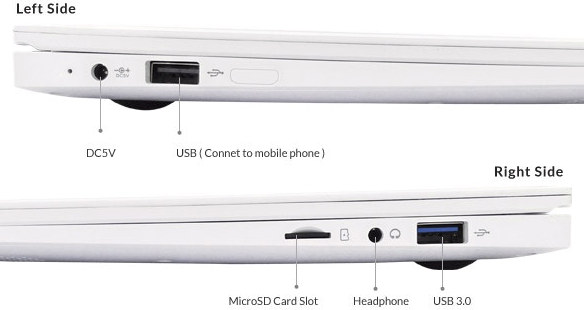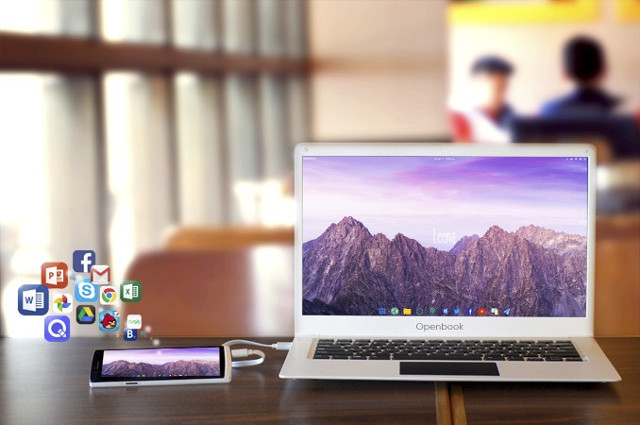Cloud Media (previously Syabas) is better known for their OpenHour and HourPopcorn Hour TV boxes, but the company also has a close relationship with Pine64 company, and helped them make Pinebook laptop powered by an Allwinner A64 ARM processor.
They’ve now used their experience, and likely some parts, from the ARM laptop to create Openbook, a 14″ laptop dock for Android smartphones.
Openbook specifications:
- USB Monitor SoC – DisplayLink DL-4000 Series USB 3.0 to LVDS/eDP SoC
- Storage – micro SD card slot
- Display – 14″ TN LCD with 1366 x 768 resolution
- QWERTY Keyboard + Large Multi-Touch Touchpad
- USB – USB 3.0 host port, USB port to connect to mobile phone
- Audio – Headphone Jack, stereo speaker, microphone
- Battery – 10,000 mAh Lithium Polymer Battery
- Power Supply – 5V/3A (DC Jack: Type H 3.5mm OD/1.35mm ID barrel ‘coaxial’ type)
- Dimensions – 329mm x 220mm x 12mm (W x D x H)
- Weight – 1.26 kg
The dock works with smartphones equipped at least with a quad core processor @ 1.5 GHz, 2GB RAM, 50MB free storage, USB type C or micro USB OTG port, and running Android 5.0 or greater. Since stock Android does not exactly offer the best desktop experience, the company has patterned with LeenaOS, multi-window launcher that brings the desktop operating system experience to your mobile device.
 Openbook is not exactly the first smartphone laptop dock, which also started with Motorola LapDock (now defunct), as new players have entered the market place including NexDock and Mirabook. Just like the two aforementioned products, Openbook also launched on a crowdfunding website, specifically Kickstarter with the goal of raising at least $30,000 for mass production.
Openbook is not exactly the first smartphone laptop dock, which also started with Motorola LapDock (now defunct), as new players have entered the market place including NexDock and Mirabook. Just like the two aforementioned products, Openbook also launched on a crowdfunding website, specifically Kickstarter with the goal of raising at least $30,000 for mass production.
A pledge of $129 should get you a white Openbook with a power adapter and a custom USB-OTG cable. Shippings adds from $22 (Hong Kong) with several other prices depending on destination up to $88, and delivery is scheduled for December 2017. The people behind Cloud Media are highly experienced in bringing products to market, so failure is very unlikely.

Jean-Luc started CNX Software in 2010 as a part-time endeavor, before quitting his job as a software engineering manager, and starting to write daily news, and reviews full time later in 2011.
Support CNX Software! Donate via cryptocurrencies, become a Patron on Patreon, or purchase goods on Amazon or Aliexpress. We also use affiliate links in articles to earn commissions if you make a purchase after clicking on those links.





The only important word above is ‘DisplayLink’. That’s also the main difference to all the other ‘similar’ solutions that use either native HDMI or DisplayPort and not ‘USB with display artefacts and (future) driver hassles’. 🙂
@tkaiser
It’s a nice looking device and I commend Cloud Media for it, but if you have to carry a laptop sized dock why not just take a light laptop instead? Or am I missing the point of this completely?
tkaiser, you make a good point too. I’ve had my fair of issues with DisplayLink!
When I attend meetings people seem happy with a tablet and keyboard, unless you are doing something which needs major processing power like video editing.
@–
Really no idea who wants to use this for what reason. And I couldn’t care less as someone who would always test laptop style devices first since I do all my work on these things and would simply get mad having to use a mediocre keyboard and/or display (not talking about this specific device just as a general rule –> visiting a local store or buying online only at sites with a ‘no questions asked’ return policy)
I just wanted to point out that this thing is something completely different than the three other things mentioned here (Motorola’s LapDock, NexDock and Mirabook) as a try to save people from doing mistakes (eg. thinking about stuff like a ‘PiTop’ combining an SBC like Pine64 or ROCK64 with this OpenBook — this here is the proprietary DisplayLink stuff so you need drivers to get the DL4000 sitting inside the device to display anything. If people confuse this ‘OpenBook’ with a NexDock they most probably just buy a pretty expensive and clumsy power bank)
“14″ TN LCD with 1366 x 768”. oh well, it’s dead to me now. At least VA or PVA or even S-IPS.
if you’re going to have a laptop-shaped dock, you need it to have a variety of functions.
keyboard, mouse and touchscreen are fairly easy, it just needs a USB hub and present these as usb devices, ideally over USB-C with an adaptor for microUSB and full-sized USB devices
the screen needs various video interfaces:
* USB-C alternative mode for video
* HDMI (then add adaptors for mini and micro HDMI, as well as DVI)
* mini displayport with an adaptor for full sized DP
* MHL, slimport, miralink and their like
* then finally a displayLink frame buffer with USB interface so it can act as a second screen to anything that has a displaylink adaptor driver
you could then use this:
* with phones and tablets which support MHL,slimport or Miralink
* desktop computers as primary or secondary display using the display port or HDMI interfaces
* with a games console as the primary display
* as a screen for a Raspberry Pi or similar small board
* with an adapter, use it with an Intel Compute Card.
* in a data center instead of a KVM trolley
is it too much to ask for this?